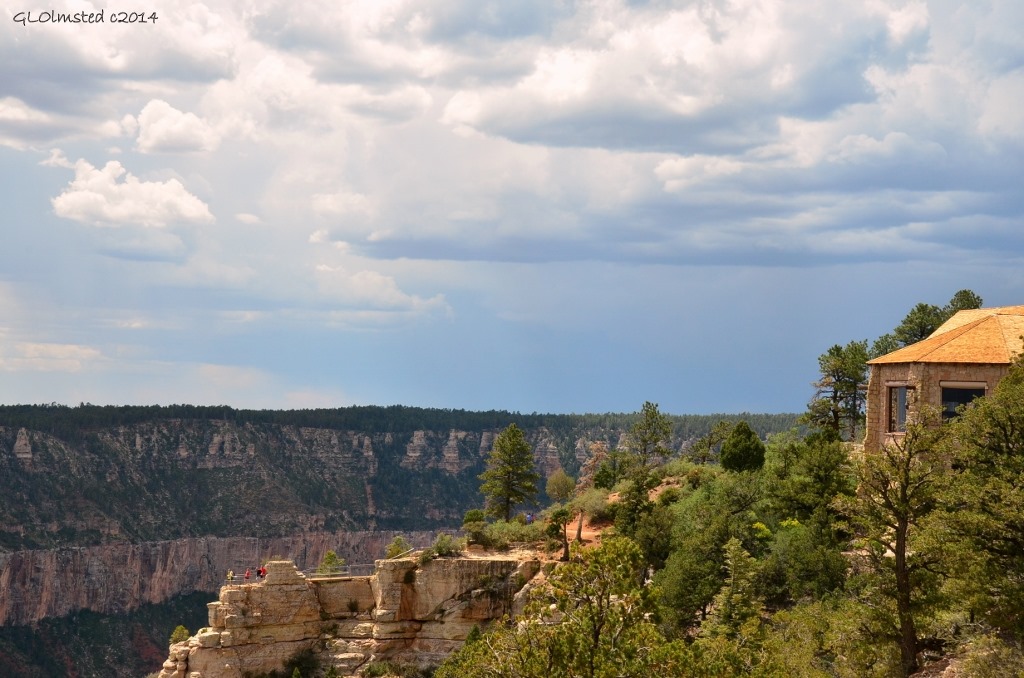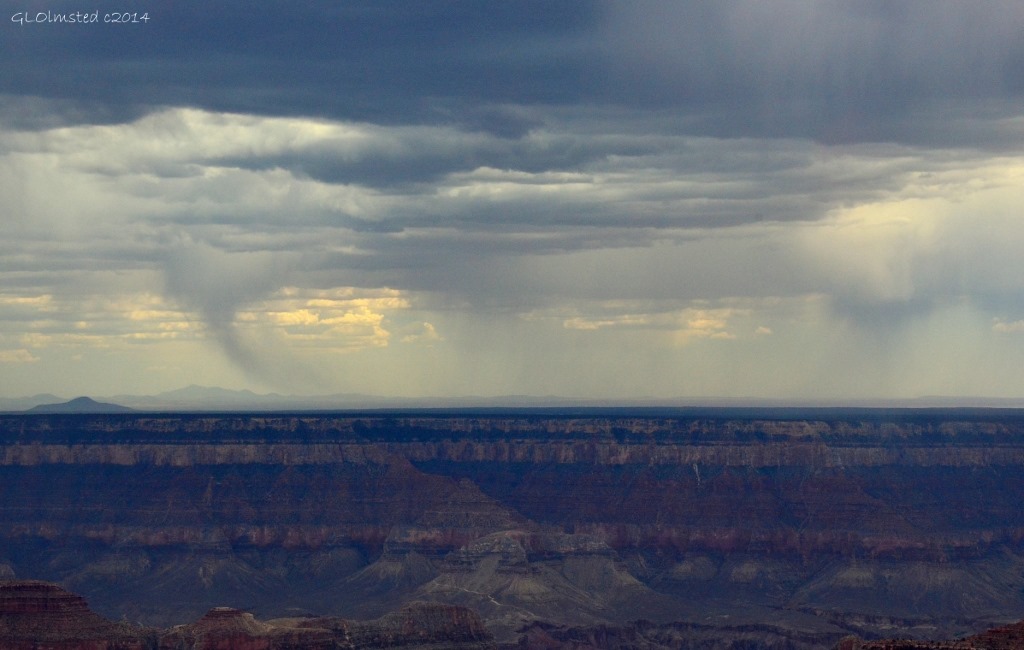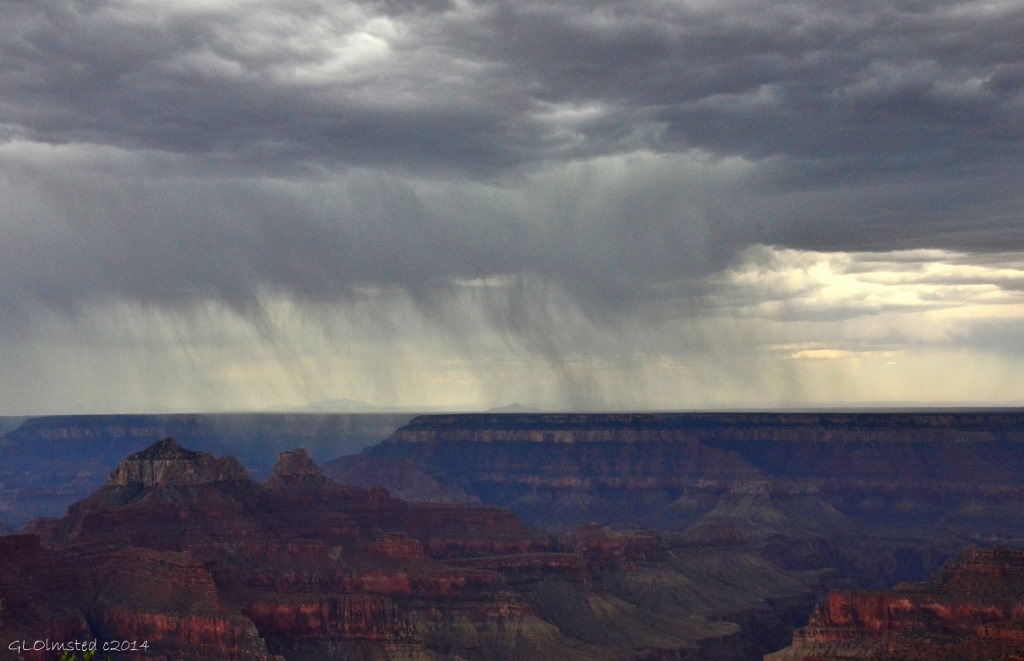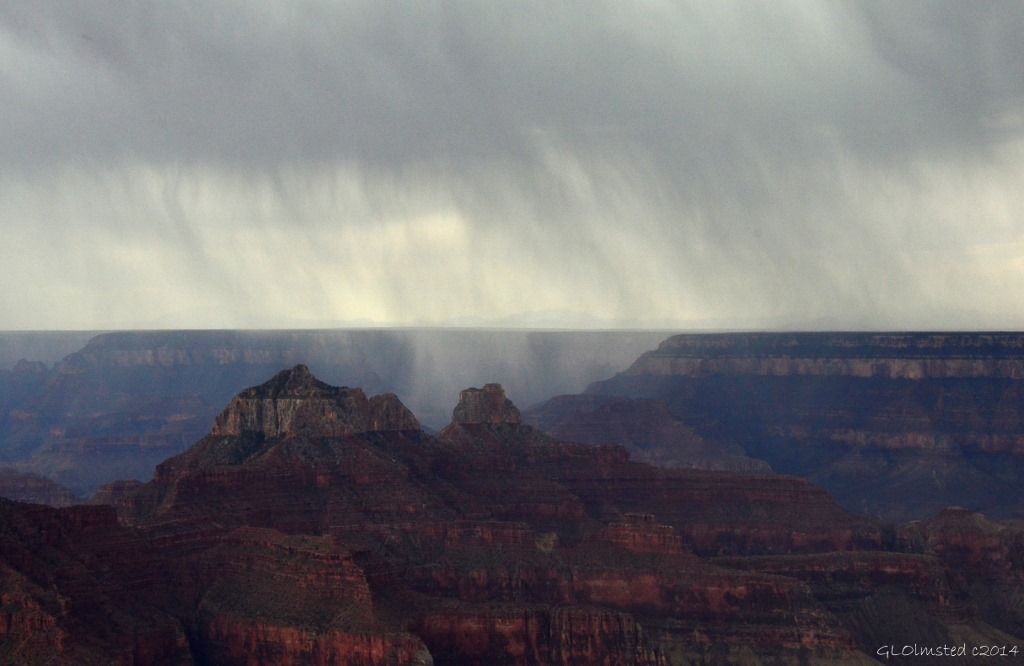 Just like clockwork, July 2nd brought the first measurable rain. And so it begins, monsoon at Grand Canyon National Park as seen from the North Rim Grand Lodge.
Just like clockwork, July 2nd brought the first measurable rain. And so it begins, monsoon at Grand Canyon National Park as seen from the North Rim Grand Lodge.
Join others that look to the sky at SkyWatch Friday.
 Just like clockwork, July 2nd brought the first measurable rain. And so it begins, monsoon at Grand Canyon National Park as seen from the North Rim Grand Lodge.
Just like clockwork, July 2nd brought the first measurable rain. And so it begins, monsoon at Grand Canyon National Park as seen from the North Rim Grand Lodge.
Join others that look to the sky at SkyWatch Friday.
 We who live on the North Rim are doing a rain dance. A little tease July 1st as dark clouds filled with thunder rolled over the Kaibab Plateau yet only a few minutes of light and playful rain fell during the 1pm Way Cool Canyon program designed for young visitors/kids. Grand Canyon monsoon, right on time. Let it rain!
We who live on the North Rim are doing a rain dance. A little tease July 1st as dark clouds filled with thunder rolled over the Kaibab Plateau yet only a few minutes of light and playful rain fell during the 1pm Way Cool Canyon program designed for young visitors/kids. Grand Canyon monsoon, right on time. Let it rain!
 The following day clouds were building at 1pm when I left the Visitor Center.
The following day clouds were building at 1pm when I left the Visitor Center.
 An hour later back on the rim for a rove to the Grand Lodge the sun still shone through in places.
An hour later back on the rim for a rove to the Grand Lodge the sun still shone through in places.
 But things were looking a little more serious over the South Rim.
But things were looking a little more serious over the South Rim.
 As I set up for a geology talk on the verandah the sky distracted me as it did for the few visitors taking photos like myself. Yet they kept an eye on me and one commented that it must be safe. “I’ll follow the Ranger.”
As I set up for a geology talk on the verandah the sky distracted me as it did for the few visitors taking photos like myself. Yet they kept an eye on me and one commented that it must be safe. “I’ll follow the Ranger.”
The storm swept eastward across the South Rim, occasional lightning made the watchers “oo and aa” as if at a fireworks display on the 4th of July. “Is it raining in the canyon Ranger?” Maybe, but probably not very far down. The rising heat often evaporates the rain before it ever hits the ground called virga. Predicted 108F at Phantom Ranch along the river today.
 As if to prove me wrong the shifting wind brings the first giant rain drops yet allows time for all to move indoors, including me with a box full of rocks and carefully protected camera. People settled and talk of geology began on time at 3pm while clouds of rain obscured the south rim leaving Oza Butte (closest peak on the right) as an island of rich layered colors. A cool refreshing breeze slipped through open windows.
As if to prove me wrong the shifting wind brings the first giant rain drops yet allows time for all to move indoors, including me with a box full of rocks and carefully protected camera. People settled and talk of geology began on time at 3pm while clouds of rain obscured the south rim leaving Oza Butte (closest peak on the right) as an island of rich layered colors. A cool refreshing breeze slipped through open windows.
 40 minutes later, camera wrapped in a plastic bag for just this purpose, I hurried back to the Visitor Center only 100 yards of light rain under dark sky. For the next half hour, non-stop, I directed visitors to the dry lodge hopefully for a view, and suggested they stay off the rim during nearby thunder and lightning. Repeatedly asked question, “when will it stop raining?”
40 minutes later, camera wrapped in a plastic bag for just this purpose, I hurried back to the Visitor Center only 100 yards of light rain under dark sky. For the next half hour, non-stop, I directed visitors to the dry lodge hopefully for a view, and suggested they stay off the rim during nearby thunder and lightning. Repeatedly asked question, “when will it stop raining?”
 Remember as a kid when you learned to count between the lightning and thunder, “One, one thousand, two, one thousand, three, one thousand…” According to NOAA (National Weather Service) every five seconds counted equals the lightning being a mile away and recommends getting to a safe location at 30 seconds, or 6 miles away. You definitely don’t want to be the tallest thing on the rim during a storm, taking photos or leaning on a metal rail. Last year at Cape Royal overlook I saw a little girls hair lifting and sent visitors back to their cars in a hurry.
Remember as a kid when you learned to count between the lightning and thunder, “One, one thousand, two, one thousand, three, one thousand…” According to NOAA (National Weather Service) every five seconds counted equals the lightning being a mile away and recommends getting to a safe location at 30 seconds, or 6 miles away. You definitely don’t want to be the tallest thing on the rim during a storm, taking photos or leaning on a metal rail. Last year at Cape Royal overlook I saw a little girls hair lifting and sent visitors back to their cars in a hurry.
By 5pm, when I left the Visitor Center the rain had stopped leaving the slightest bit of moisture under the pines, even a few small puddles in the parking lot. I felt the forest sigh, the smell of fresh washed air divine. The soil, unfortunately is dry in less than 1/4 inch.
After dinner I gave a “campfireless” talk due to fire restrictions. It is not enough rain, yet, to be playing with fire. Will it rain tonight? Probably not I tell campers. But tomorrow is a different story. Hiking before 11am stands a better chance of sunshine. Afternoon rains are likely so be prepared. Let it rain!
During July and August monsoon season brings much need moisture to the Southwest. Unfortunately for visiting tourists, who seem to think all of Arizona is a constantly dry desert, rain will most likely happen almost every afternoon. So the number one question Park Rangers at Grand Canyon hear is, “When will it quit raining?” We are not weather forecasters, but we can tell you about monsoon, how to be prepared and to have patience for some possibly most amazing views.
The term monsoon comes from the Arabic mausin, a season of high temperatures, high winds and high moisture. This seasonal phenomena occurs in other regions of the world including Asia, South America and Africa. The North America monsoon occurs over northwest Mexico, Arizona, New Mexico and parts of Colorado and Utah.
During winter Arizona’s primary wind flow comes from the west or northwest, across the land and towards the ocean, making the air dry. That’s one of the reasons the southern desert offers major appeal to northerners, or snowbirds, who spend winter in a delightful summer-like atmosphere. But they’ve left by spring when early summer temperatures increase to sometimes stupidly high and the remaining hardy desert residents anticipate the moisture laden monsoon to cool things off a bit.
When the wind shifts and comes from the south sometime in July, now ocean to land, moisture held in huge upper air subtropical high pressure cells (read huge fluffy clouds) meet the intense heat rising off the desert causing thunderheads to grow bringing the increased chance of usually afternoon storms. Downpours, or bursts, are often short in duration followed by breaks. These storms can be especially strong at elevation and the Colorado Plateau ranges from 7,000 to 10,000 feet (2133 to 3048 m).
Of course sometimes the rain never touches the ground due to the extreme heat and evaporation. Called Virga, the effect is stunning when viewed across canyon.
Monsoon season does not end as abruptly as it begins. While it takes time for the land to heat up, it also takes time for that land to cool in the fall. This makes monsoon season a time of rainfall that diminishes rather than ends.
In 2008 the National Weather Service decided from now on June 15 will be the first day of the monsoon, and September 30 will be the last day. Of course that doesn’t mean it will rain constantly between those dates. I think they are just covering their butts.
Add to monsoon the possibility of tropical storms, or waves, that equate to an increase of rain, very steady for as long as it hangs out. In August 2013 this lasted almost three days as low pressure to the east held Tropical Storm Ivo in place on the Kaibab Plateau. Tropical storms can preclude a hurricane which are exceedingly rare, but not impossible, in Arizona.
The second most common question as a Park Ranger during monsoon season is, “What can we do in the rain?”
I sympathize that visitors on vacation would all like ideal weather conditions, not too hot, not too cold, not too wet. Maybe a little pre-planning would help plus being prepared for all kinds of weather.
Typical monsoon—if there’s anything typical about weather—doesn’t usually bring rain until after 11 am so get out to hike and enjoy the canyon views in the morning. Later in the afternoon the sky often clears. And sometimes brilliant sunsets flare over the canyon.
Hang out in the Grand Lodge where either the Sunroom or Auditorium offer panoramic windows and even if there’s a white out, just wait a few minutes and the view will change.
Always have your eye on the sky and be aware of your surroundings when engaged in outside activities.
Hair standing up is a sign that static charge is nearby. Don’t be the tallest thing standing at the rim of the canyon. When a storm is near the safest places to be are in a vehicle or building. If that’s not possible, move back from the rim and into the forest, just not under the tallest trees. One in ten of the large Ponderosa Pines at the North Rim have been struck by lightning. They are fire resistant, we are not. Look for low, even, bunched vegetation and get small. Crouch down with your feet together reducing your point of contact to the ground. Don’t bunch together. Instead spread out at least 10-12 feet between people. This may sound extreme and only needs to be advised when lightning is directly overhead. To estimate the distance between you and a lightning flash count seconds between lightning and thunder with every five seconds equaling about one mile.
That award winning photo of lightning isn’t worth your life. People die every year in or near Grand Canyon National Park from lightning. Please don’t become a statistic. Be lightning smart.
With the rain comes the floods. Canyon rims are rock so water flows over the rim sometimes creating waterfalls that are rarely seen at any other time. All this water can create rock slides as well as make a steep trail a slippery mess. Hiking in the canyon can become quite perilous.
And when driving off the plateau be aware of the possibility of flash flood. The hard packed desert soil doesn’t make a good sponge during heavy downpours. Rain at high elevation sends water down below with the worst areas for flooding being the many washes and small gullies that have drained the land long before roads where built. Even if the water rushing across the road only looks an inch or two deep it might really be a foot or more. There may be unseen broken pavement, vehicles can get stuck or stalled, and fast flowing water is capable of moving even high clearance trucks. The wash on each side of the above road is 30 feet deep. Arizona has a ‘Stupid Motorist Law’ that allows municipalities and rescue agencies to charge people the cost of being rescued if they fail to observe posted warnings.
Check out David Rankin’s videos of flash floods in the Southwest to see the raw power of water.
I spend many hours trying to lift the spirits of rain depressed tourists. OK, so I know visitors come to Grand Canyon to see the iconic blue skies over layers of red and gold. These are the images that everyone has seen. After many seasons here I only see fog and clouds in the canyon a few times every summer. This is special magic.
I recommend patience as the view can change from total whiteout to tiny peeks, rock temples floating above the sea of cloud and drifting clouds deep in the canyon with even a surprise burst of sunshine. Take lots of photos of this amazing phenomenon to share with friends and family who undoubtedly have seen the iconic images of Grand Canyon, but not this special treat.
One foggy day I went on to the Walhalla Plateau bringing along rain-gear. Eight visitors enjoyed a break with warming sunshine for my Archeology talk which ended with fog rolling over the rim, and us.
Then I braved through the fog towards the end of the road to Angels Window and Cape Royal knowing the clouds would be playing games of hide-and-seek all over the canyon.
A massive monsoon darkened the sky above the opposite South Rim providing a lightning show. I was so busy taking video to capture a flash that a visitor startled me when he asked if I’d be giving the 3:00 geology talk. When I turned around and saw a woman’s hair standing on end like a glow around her head that was enough to shag everybody off the exposed overlook and back to their vehicles. Sure wish I’d taken a photo of that.
My last stop of that day at Point Imperial revealed sun shining on the distant Vermilion Cliffs. Just another act in the Greatest Earth on Show.
Rain brings life and death to America’s Southwest. It’s been a wet summer, and we needed that as there was a very low winter snowpack.
You won’t melt in the rain, so get out there. Enjoy the magic. But keep your eye on the sky during monsoon.